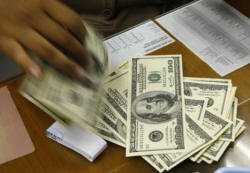|
 Dollar
eases, weak U.S. jobs data dent hopes of early rate hike Dollar
eases, weak U.S. jobs data dent hopes of early rate hike
 Send a link to a friend
Send a link to a friend
[April 06, 2015]
By Shinichi Saoshiro
TOKYO (Reuters) - The dollar weakened
across the board on Monday, after much weaker-than-expected U.S. jobs
data persuaded many in the market that the Federal Reserve is likely to
wait until the second half of 2015 before raising interest rates.
|
|
 Friday's closely watched employment data showed U.S. non-farm
payrolls rose by 126,000 in March, the smallest gain since December
2013 and well under the 245,000 economists had forecast. On the
brighter side, average hourly earnings increased 0.3 percent. Friday's closely watched employment data showed U.S. non-farm
payrolls rose by 126,000 in March, the smallest gain since December
2013 and well under the 245,000 economists had forecast. On the
brighter side, average hourly earnings increased 0.3 percent.
The employment data was the latest in a recent series of indicators
that portrayed the U.S. economy in a less flattering light and seen
making the Fed more cautious toward raising rates.
"Market expectations had momentarily lurched toward a June rate
hike, but such prospects have ebbed. A fifty-fifty chance of a hike
in September, and that being the only tightening this year, is the
view now being re-established," said Koji Fukaya, president at FPG
Securities in Tokyo.

The dollar weakened as U.S. Treasury yields sank in wake of the soft
jobs data on Friday - albeit in thin trading due to the Good Friday
holiday. The benchmark 10-year note yield <US10YT=RR> fell to a
two-month low of 1.8 percent on Friday and last hovered around 1.83
percent.
The euro was up 0.1 percent at $1.0980 <EUR=> after touching
$1.1018. The common currency had gone as low as $1.0864 before
surging on the U.S. jobs data.
The dollar nudged up 0.1 percent to 119.08 yen <JPY=> after sliding
from a high of 119.99 on Friday. The dollar had hit a near
eight-year high of 122.04 a month ago, when expectations for a Fed
rate hike as early as June were stronger thanks in part to strong
non-farm payrolls.
Market participants saw diverging monetary policies still favouring
the dollar in the long run. The Fed's counterparts like the European
Central Bank and Bank of Japan are deeply committed to easy
policies.
"We still see the dollar trending higher in the longer term. The
jobs data headline was certainly soft, but we have to consider that
jobs had been roughly growing at a pace of 200,000 a month for a
year. The rise in earnings was also a plus," said Kyosuke Suzuki,
director of forex at Societe Generale in Tokyo.
[to top of second column] |

"Indicators like housing-related data, consumer confidence and
initial jobless claims paint a brighter picture and the April
non-farm payrolls could give an upside surprise. It helps explain
why the dollar's reaction is confined to a 1-yen range so far," he
said.
Buoyed by the dollar's broad decline, sterling extended gains
against the U.S. currency. The pound was a touch higher at$1.4920,
adding to Friday's 0.6 percent gain. Prior to the surge the pound
had been weighed down by concerns over political risk ahead of a
national election on May 7.
The Australian dollar was little changed at $0.7620. The Aussie has
crawled back from a six-year trough of $0.7534 plumbed last week but
its recovery was capped by some expectations that Reserve Bank of
Australia will cut interest rates on Tuesday.
Debt markets imply about a 75 percent chance of a quarter point
easing by the RBA on Tuesday.
(Editing by Eric Meijer and Simon Cameron-Moore)
[© 2015 Thomson Reuters. All rights
reserved.] Copyright 2015 Reuters. All rights reserved. This material may not be published,
broadcast, rewritten or redistributed.
 |